Lipid bilayer Study guides, Class notes & Summaries
Looking for the best study guides, study notes and summaries about Lipid bilayer? On this page you'll find 3191 study documents about Lipid bilayer.
Page 3 out of 3.191 results
Sort by
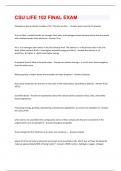
-
CSU LIFE 102 FINAL EXAM QUESTIONS & ANSWERS SOLVED 100% CORRECT!
- Exam (elaborations) • 17 pages • 2024
- Available in package deal
-
- $7.99
- 1x sold
- + learn more
Phosphorus has an atomic number of 15. This tells us that... - Answer-there must be 15 protons True or False: covalent bonds are stronger than ionic and hydrogen bonds because atoms that are joined with covalent bonds share electrons - Answer-True An e- in a hydrogen atom exists in the first valence shell. The valence e- of Aluminum exist in the 3rd shell. Which valence shell e- have higher potential energy and why? - Answer-the valence e- of aluminum, bc higher e- shells have higher energy...
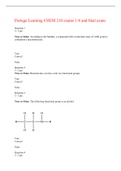
-
PORTAGE LEARNING CHEM 210 exams 1-8 and final exam
- Exam (elaborations) • 124 pages • 2023
-
- $28.99
- 5x sold
- + learn more
Portage Learning CHEM 210 exams 1-8 and final exam Question 1 3 / 3 pts True or False: According to the Module, a compound with a molecular mass of 1,000 g/mol is considered a macromolecule. True Correct! False Question 2 3 / 3 pts True or False: Biomolecules can have only two functional groups. True Correct! False Question 3 3 / 3 pts True or False: The following functional group is an alcohol. True Correct! False Question 4 3 / 3 pts True or False: In ...
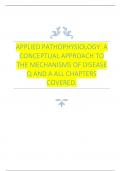
-
APPLIED PATHOPHYSIOLOGY: A CONCEPTUAL APPROACH TO THE MECHANISMS OF DISEASE Q AND A ALL CHAPTERS COVERED.
- Exam (elaborations) • 123 pages • 2023
-
- $15.00
- 1x sold
- + learn more
1. The nucleus , which is essential for function and survival of the cell. A) is the site of protein synthesis B) contains the genetic code C) transforms cellular energy D) initiates aerobic metabolism 2. Although energy is not made in mitochondria, they are known as the power plants of the cell because they: A) contain RNA for protein synthesis. B) utilize glycolysis for oxidative energy. C) extract energy from organic compounds. D) store calcium bonds for muscle contractions. 3. Although the b...

-
ANATOMY AND PHYSIOLOGY TEST 1/2/3/4/5/6/7 QUESTIONS AND ANSWERS LATEST UPDATED 2023
- Exam (elaborations) • 33 pages • 2023
-
- $13.49
- 1x sold
- + learn more
ANATOMY AND PHYSIOLOGY TEST 1/2/3/4/5/6/7 QUESTIONS AND ANSWERS LATEST UPDATED 2023. How can such a weak bond like hydrogen bond work to make DNA such a stable molecule? - ANSWER hydrogen bonds bond DNA into its double-helix structure by holding together the base pairs in the middle; they cause molecules to fold and coil into precise threedimensional shapes which elements are found in organic molecules? - ANSWER carbon, hydrogen, and oxygen acid - ANSWER proton donor base - ANSWER proton ac...
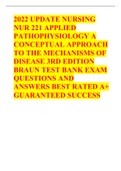
-
TEST BANK FOR APPLIED PATHOPHYSIOLOGY A CONCEPTUAL APPROACH TO THE MECHANISMS OF DISEASE - 3RD EDITION BRAUN QUESTIONS AND ANSWERS
- Exam (elaborations) • 205 pages • 2023
- Available in package deal
-
- $16.49
- 1x sold
- + learn more
TEST BANK FOR APPLIED PATHOPHYSIOLOGY A CONCEPTUAL APPROACH TO THE MECHANISMS OF DISEASE - 3RD EDITION BRAUN QUESTIONS AND ANSWERS Chapter 1Introduction to Pathophysiology 1. The nucleus , which is essential for function and survival of the cell. A) is the site of protein synthesis B) contains the genetic code C) transforms cellular energy D) initiates aerobic metabolism 2. Although energy is not made in mitochondria, they are known as the power plants of the cell because they: A) contain RNA fo...
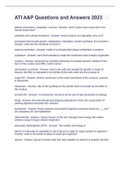
-
ATI A&P Questions and Answers 2023
- Exam (elaborations) • 25 pages • 2023
- Available in package deal
-
- $10.49
- 2x sold
- + learn more
plasma membrane, cytoplasm, nucleus - Answer- what 3 parts does every cell in the human body have? metabolic life (cellular functions) - Answer- what functions do organelles carry out? processes that include growth, metabolism, replication, protein synthesis, & movement - Answer- what are the metabolic functions? plasma membrane - Answer- made of a phospholipid bilayer embedded w proteins cytoplasm - Answer- semi fluid substance inside the membrane that contains organelles nucleus...
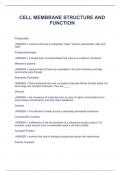
-
CELL MEMBRANE STRUCTURE AND FUNCTION Phospholipid ANSWER = molecule that has a hydrophillic "head", and two hydrophobic, fatty acid "tails" Phospholipid bilayer ANSWER = a double layer of phospholipids that makes up a plasma membrane Membrane
- Exam (elaborations) • 3 pages • 2023
-
- $12.49
- + learn more
CELL MEMBRANE STRUCTURE AND FUNCTION SOLUTIONS
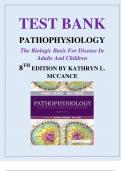
-
Test Bank For McCance & Huether’s Pathophysiology The Biologic Basis for Disease in Adults and Children 9th Edition By Julia Rogers | 2024/2025 | 9780323789882 |Chapter 1- 49 | Complete Questions and Answers A+
- Exam (elaborations) • 508 pages • 2023
-
- $15.49
- 1x sold
- + learn more
TEST BANK PATHOPHYSIOLOGY The Biologic Basis For Disease In Adults And Children 8TH EDITION BY KATHRYN L. MCCANCE McCance: Pathophysiology: The Biologic Basis for Disease in Adults and Children (8th Edition) TEST BANK CONTENTS: Chapter 01: Cellular Biology Chapter 02: Altered Cellular and Tissue Biology: Environmental Agents Chapter 03: The Cellular Environment: Fluids and Electrolytes, Acids and Bases Chapter 04: Genes and Genetic Diseases Chapter 05: Genes, Environment-Lifes...
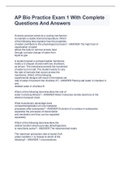
-
AP Bio Practice Exam 1 With Complete Questions And Answers
- Exam (elaborations) • 9 pages • 2023
- Available in package deal
-
- $11.99
- 2x sold
- + learn more
Humans produce sweat as a cooling mechanism to maintain a stable internal temperature. Which of the following best explains how the properties of water contribute to this physiological process? - ANSWER The high heat of vaporization of water allows the body to remove excess heat through a phase change of water from liquid to gas A student placed a semipermeable membrane inside a U-shaped channel with two chambers, as shown. The membrane permits the movement of water but not salt. The...
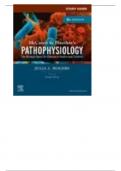
-
TEST BANK PATHOPHYSIOLOGY THE BIOLOGICAL BASIS FOR DISEASE IN ADULTS AND CHILDREN BY McCance
- Exam (elaborations) • 493 pages • 2023
- Available in package deal
-
- $6.69
- 3x sold
- + learn more
TEST BANK PATHOPHYSIOLOGY THE BIOLOGICAL BASIS FOR DISEASE IN ADULTS AND CHILDREN BY McCance Chapter 1: Cellular Biology MULTIPLE CHOICE 1. Which statement best describes the cellular function of metabolic absorption? a. Cells can produce proteins. c. Cells can take in and use nutrients. b. Cells can secrete digestive enzymes. d. Cells can synthesize fats. ANS: C In metabolic absorption, all cells take in and use nutrients and other substances from their surroundings. The remaini...

That summary you just bought made someone very happy. Also get paid weekly? Sell your study resources on Stuvia! Discover all about earning on Stuvia


